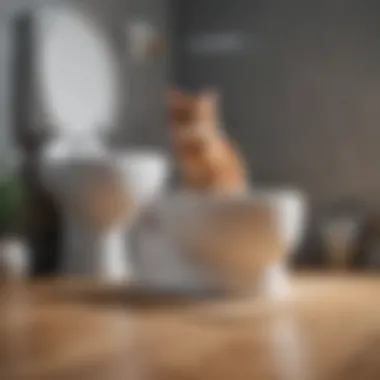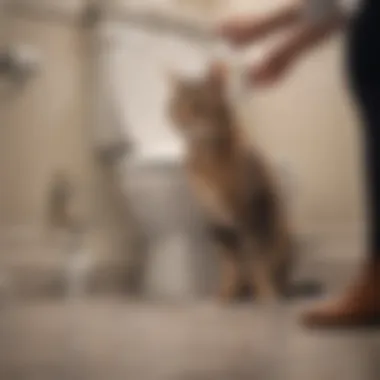Top Cat Toilet Training Systems: Features and Benefits


Intro
Toilet training a cat can be a rewarding yet challenging endeavor. Understanding how to best approach this process is key for cat owners who desire to make this transition smooth and efficient for their feline companions. This article covers various cat toilet training systems, providing insights into their features, benefits, and possible downsides. The goal is to equip readers with the knowledge needed to select the right product and methodology suited to their cat’s unique temperament and needs.
Animal Overview
Common Name and Scientific Classification
The common name for the domestic feline is
Prelude to Cat Toilet Training
Toilet training your cat is a unique endeavor that involves more than just teaching a pet to use the toilet. This process reshapes both the cat’s habits and the owner’s expectations. The practices involved in cat toilet training can significantly alter the dynamic between pets and their owners. It encourages an understanding of feline behavior, promoting a more respectful approach to their needs and actions.
Understanding the Concept of Toilet Training
Toilet training involves a systematic approach to teach your cat to relieve itself in a toilet rather than in a litter box. This process generally includes several phases, beginning with the gradual introduction of the training system to the cat and eventually transitioning to using the toilet. Key components include patience, an understanding of feline behavior, and a suitable environment for the cat to adjust to these changes. Unlike litter box training, which is more common and straightforward, toilet training requires a different set of techniques that focus on the specific needs and instincts of your cat.
The training systems often utilize a tray that fits over the toilet bowl, containing litter or a gradual reduction of restrictiveness to promote the feline’s adaptation. Understanding this process is crucial for any owner considering this method of training.
Benefits of Toilet Training Your Cat
There are several benefits that may arise from successfully toilet training your cat. These advantages may motivate many owners to pursue this method:
- Reduced Odor and Mess: Toilet training can lead to a significant reduction in the smell that is often associated with litter boxes. This improvement can enhance the overall cleanliness of the home.
- Convenience: Eliminating the need for a litter box means less cleaning and less frequent trips to buy litter, making life easier for busy cat owners.
- Space Saving: Relinquishing the litter box allows valuable space to be used for other purposes, especially in small homes.
- Enhanced Hygiene: Toilets are generally considered to be more sanitary than litter boxes, reducing the risk of certain health issues for both the pets and their owners.
Moreover, many believe that toilet training can foster an improved bond with their cats, as pets learn to adapt to a new routine and owners gain insights into their animals’ natural behaviors.
Despite the challenges, the benefits can make it a worthwhile endeavor for many cat owners. Understanding these aspects forms the basis for a better-informed decision regarding toilet training.
Factors Influencing Success in Toilet Training
Toilet training a cat is not just a matter of convenience; it involves understanding various factors that can significantly influence the success of the training process. Cats, with their unique personalities and behavioral patterns, require tailored approaches. Recognizing these influencing elements can greatly enhance the chances of effectively training a cat to use the toilet instead of a litter box. Below, we explore the important aspects that play a role in this endeavor.
Cat's Age and Personality
A cat's age and personality are crucial in determining how well it will respond to toilet training. Kittens are generally more adaptable and may adjust to new habits quicker than older cats. This is often due to their unmatched curiosity and less ingrained behaviors learned through years of litter box use. However, each cat is unique. Some adults may be willing to adapt if they have a playful and eager temperament.
Older cats might struggle more with the transition. They may have developed stronger habits, making it difficult to change their routines. Additionally, older or more anxious cats may find the toilet unfamiliar and stress-inducing, leading to potential issues.
A cat's temperament also matters. Cats that are naturally inquisitive may be more receptive to the concept of toilet training, while shy cats might hesitate. Understanding these personalities can aid owners in crafting a training plan that aligns with their cat’s inherent traits.
Environmental Factors
The environment where the toilet training takes place can significantly affect the process. Cats thrive in stable and safe surroundings, so any sudden changes might hinder their ability to learn or adapt. Key considerations include:
- Location of the Training System: The toilet training system should be placed in a low-traffic area. This ensures that the cat feels secure while using it. Avoid sudden changes in its placement, as cats can be sensitive to their surroundings.
- Noise and Distractions: Cats can be easily distracted by loud noises or sudden movements. A calm environment can help them focus on the training.
- Household Dynamics: If there are several pets or children in the house, their presence might create unwanted stress. Owners should ensure their cat feels comfortable and unbothered during this transition.
The overall cleanliness of the training area is also vital. A clean and well-maintained toilet area helps keep the cat interested and encourages regular use.


Owner's Commitment and Patience
The owner's commitment and patience are arguably the most significant factors in successful cat toilet training. Training a cat requires time, consistency, and dedication. Here are essential elements:
- Consistency in Training: Owners must adhere to a consistent training routine. Regularly scheduled training sessions help reinforce learning.
- Positive Reinforcement: Encouragement through praise or treats can reinforce good behavior effectively. This motivates cats to respond positively throughout the process.
- Understanding Setbacks: Owners must anticipate possible setbacks and not get disheartened. Each cat may progress at its own pace, and some may revert to old habits. Recognizing that this is a part of the learning journey is essential.
- Availability to Guide: Owners need to be accessible during training. Being present allows for immediate feedback and correction if the cat struggles.
"Toilet training a cat is not just about convenience; it is a journey that requires understanding, consistency, and nurturing."
In the realm of cat ownership, the integration of toilet training systems stands out as a novel solution to a common issue. Understanding various systems in this guide aids cat owners in making informed decisions. Proper knowledge about the available options can significantly ease the transition from litter boxes to toilets for both pet and owner.
Each system offers its own unique approach and design. Some systems simplify the removal of litter as the cat learns to navigate the toilet structure. Others rely on gradual steps, allowing the cat to acclimate comfortably. Key benefits include simplified cleaning and reduced odor. The cat may also experience less stress when adjusting to using the toilet. These advantages are essential in evaluating any product.
Selecting the right system requires consideration of several factors, including the age and personality of the cat, the physical space in the home, and the owners' lifestyle. An effective toilet training system will not just provide a method but also enable an enriched bonding experience between the cat and its owner.
Detailed Review of Leading Products
A thorough examination of leading products allows cat owners to make informed decisions when selecting a toilet training system. Each product presents unique characteristics, benefits, and potential limitations. Understanding these aspects is vital, as the right system can significantly enhance the training process. As cat owners consider these products, they should evaluate factors such as ease of use, effectiveness, and adaptability to their feline's needs.
Litter Kwitter
Litter Kwitter aims to simplify the transition from litter box to toilet with its unique three-phase training system. This product includes a series of removable training discs, which gradually acclimate cats to using the toilet. The initial disc fits snugly in the toilet bowl, while a progressive approach helps reduce dependence on litter. One advantage of Litter Kwitter is its structured training process. It provides clear guidance for cat owners, offering a step-by-step method that can ease potential frustrations. However, some cats may require more time than others to adjust to the change, and their proclivity to stray from the system should be monitored.
CitiKitty
CitiKitty offers a distinct training kit that includes a sturdy training seat designed to fit most standard toilets. Like Litter Kwitter, it features a gradual process, transitioning from litter to toilet use. The system is known for its excellent user reviews, indicating overall satisfaction among pet owners. Its design promotes less mess and simplifies cleanup, making it an attractive choice. Still, one consideration is that some cats may resist the change. It may require commitment and time from the owner. Ensuring that every cat's personality metrics are accounted for is critical in achieving success.
PetFusion
PetFusion’s training system is distinct due to its focus on both functionality and aesthetic appeal. This product includes a high-quality toilet training seat made of durable materials. The design ensures a secure fit on the toilet while being easy to remove for cleaning. PetFusion emphasizes the importance of a gradual training process, incorporating multiple ring adjustments as cats progress. This adaptability is a significant advantage, catering to varying cat sizes and species. Yet, like other products, patience is key. Not every cat will adapt at the same rate, and owners should be prepared to adapt their approach as needed.
Others Worth Considering
While Litter Kwitter, CitiKitty, and PetFusion are prominent options, there are several other alternatives. Products such as the KarmaKitty and the Kitty Kotty systems offer various features designed to accommodate unique training needs. For instance, KarmaKitty incorporates a flexible training stage, allowing for adjustments as cats become more adept. Alongside these, alternative methods such as training pads or gradual training techniques can also be considered.
In summary, evaluating leading products against personal circumstances and the unique behavior of one's cat is essential. This detailed review serves as a foundation for cat owners to initiate their journey towards successful toilet training.
Step-by-Step Guide to Toilet Training
Toilet training a cat can seem like an intimidating task. However, when approached correctly, it can lead to an efficient and rewarding experience for both pet and owner. Understanding the step-by-step process is critical to ensuring that the training is smooth and effective. Each step builds upon the previous one, making sure that the cat fully understands what is expected. This guides the cat owner in executing the training plan with clarity.
Preparation for Training
Before starting the toilet training process, several preparations are essential. First, assess the cat's age and overall temperament. Young cats or those with a curious disposition may adapt more quickly. Alternatively, older cats might require more time to adjust. Next, choose an appropriate training system. Options like Litter Kwitter or CitiKitty provide structured methods to ease the transition.
The environment must also be considered. A quiet and stress-free area is paramount for effective training. It should be devoid of distractions, allowing the cat to feel comfortable. It may be necessary to gradually phase out the traditional litter box before introducing the toilet training system. Make sure your cat is familiar with using a litter box before initiating this transition.
Introducing the Training System
Once preparations are complete, it’s time to introduce the training system to your cat. Begin by placing the training apparatus next to the existing litter box. This allows the cat to explore it without pressure. Familiarization is key. Many systems require some initial assembly; ensure it is set up correctly to avoid confusion.


Once the apparatus is in place, gently guide the cat to it. Reward the cat with treats or positive reinforcement when they show interest or use the system. This is a vital step, as it creates a positive association with the training system.
Phased Approach to Training
The phased approach is an effective methodology that simplifies the process. Gradually changing the system can help acclimate the cat. The first phase typically involves raising the toilet seat to the same height as the litter box. This gradual elevation eases the cat into the new routine.
As progress occurs, start adding water to the training system. This adjustment encourages the cat to aim for the center, mimicking natural behavior. Each phase should last as long as necessary until the cat appears comfortable and proficient before moving on.
Monitoring Progress and Adjustments
Monitoring your cat's progress is essential in this journey. Keep an eye on their behavior and adapt as needed. If the cat seems hesitant or has accidents, reassess the training pace. Some cats may take longer to adapt than others, and it’s important to respect their rhythm.
Regular observations can also highlight any issues worth addressing. Ensure that the toilet training system remains clean and inviting. If necessary, revert to a previous phase until the cat feels ready to proceed. Patience is key in this process, as each cat is unique and will take different amounts of time to complete the training.
Remember: Consistency and positive reinforcement are critical in supporting the cat's learning journey.
Addressing Challenges During Training
Training a cat to use the toilet requires attention to various challenges that may arise. Addressing these challenges is essential for ensuring a smooth transition and minimizing stress for both the cat and its owner. Understanding potential issues allows for a proactive approach, making the overall process more effective. Here, we explore common behavioral issues, how to deal with setbacks, and when it's necessary to reassess training methods.
Common Behavioral Issues
During the toilet training process, cat owners might encounter several behavioral issues. These can stem from stress, confusion, or resistance. Some common behavioral issues include:
- Withholding Urination: Cats might refuse to use the training system due to anxiety. This can lead to urinary issues and risks to their health.
- Inappropriate Elimination: Some cats may revert to using the litter box or other areas in the home if they feel uncomfortable or if the setup is ineffective.
- Disinterest in Training: Cats are independent creatures. They may be uninterested in the training method, especially if they have not connected it with a positive experience.
Recognizing these behaviors is crucial. Owners can adjust their methods, providing positive reinforcement and ensuring the environment is comforting for the cat.
Dealing with Setbacks
Setbacks are common in any training process, including toilet training for cats. Owners should remain calm and patient when faced with difficulties. Here are some strategies to handle setbacks:
- Reevaluate the Training System: Sometimes the training system may not suit the cat. Owners should consider switching to a different product, like Litter Kwitter or CitiKitty, which may be more effective.
- Modify the Environment: Factors such as noise, location, and other pets can affect a cat's willingness to use a toilet training system. Adjusting these external factors can sometimes resolve issues.
- Persistent Positive Reinforcement: Keeping a positive attitude is key. Offering treats, praises, and gentle encouragement can help the cat associate the training process with rewards.
Being adaptable and willing to modify the approach is vital for overcoming training setbacks.
When to Reassess the Approach
It’s crucial for owners to know when to reassess their training methods. If a cat shows persistent avoidance or regression, it may be time to step back and evaluate the strategy:
- Long-term Resistance: If a cat consistently refuses to engage with the toilet training system over several weeks, it may not be the right fit. Look for signs of stress or fear.
- Health Concerns: If improper elimination habits or health issues emerge, consult a veterinarian. Some health problems could result in behavioral changes.
- Personal Stress Levels: If necessary, owners should evaluate their own stress during the process. High levels of frustration can transfer to the cat, inhibiting progress.
Listening to the cat’s needs and adapting accordingly is essential in determining the effectiveness of the approach.
Successful toilet training involves awareness of challenges and readiness to adapt strategies based on the cat's reactions and behaviors.
In summary, addressing challenges during cat toilet training is fundamental. It allows for quick adjustments that can lead to a successful and stress-free experience for both the pet and owner.
Maintaining a Successful Routine


To achieve success in cat toilet training, maintaining a consistent routine is crucial. Once training is completed, the responsibility shifts to the owner to ensure that the cat continues to use the toilet correctly. A successful routine includes several elements that reinforce the training and cater to the pet's needs.
Establishing a daily schedule helps both the owner and the cat. Cats thrive on predictability, so having a set time for feeding and access to the toilet area aids in reducing confusion. This reduces the likelihood of accidents and reinforces the expected behavior. Involvement in post-training care is necessary to maintain the progress made during training.
Post-Training Care
Post-training care is vital after your cat has successfully transitioned to using the toilet. Owners should monitor their cats closely for any signs of distress or hesitation in using the toilet. It’s also important to ensure that the toilet remains accessible and clean. Here are some key aspects of post-training care:
- Monitor Usage: Pay attention to the frequency and patterns of your cat's usage, as changes may indicate issues.
- Maintain Cleanliness: Keep the toilet clean to encourage continued use. A dirty toilet can deter your cat from using it. Regularly check the system for clogs or other blockages, as these can create additional problems.
- Adjust Adaptations: If necessary, adjust the height or position of the toilet to ensure your cat feels comfortable using it.
- Health Checks: Any changes in behavior, such as reluctance to use the toilet, may warrant a veterinary consultation. Issues like urinary tract infections must be ruled out or addressed promptly.
Incorporating Litter Box Preferences
Despite the training efforts, some cats retain specific preferences regarding litter box behaviors. Understanding these preferences can be essential in ensuring ongoing success. Incorporating these preferences helps ease the transition to toilet use. Here are a few considerations:
- Identify Preferences: Some cats prefer certain textures or scents. Observing these preferences can guide the selection of training products.
- Gradual Transition: If a cat appears hesitant about toilet usage, consider offering a small litter box near the toilet, slowly moving it away as the cat adjusts. This method can smooth the shift from a litter box to the toilet.
- Considerations for Older Cats: Older or less agile cats may struggle with toilet training. Adapting litter options while still encouraging toilet use is essential.
Establishing and maintaining a successful routine embraces much more than simple compliance. It involves understanding your cat’s unique needs and being proactive in addressing them. This attention to detail can significantly enhance the overall success of toilet training.
Expert Opinions and Insights
In the realm of cat toilet training, expert opinions provide a critical lens through which to evaluate the efficacy and best practices of various training systems. With a blend of veterinary knowledge and behavioral insights, professionals offer valuable perspectives that can significantly influence both the choice of training system and the approach taken by cat owners.
Veterinary perspectives are indispensable as they are grounded in an understanding of feline health and behavior. A veterinarian's guidance can help ensure that the training process is safe for the cat, considering factors like age, health status, and even pre-existing behavioral issues. Each cat is a unique individual, and insights from veterinarians can tailor training to fit specific needs.
Veterinary Perspectives
Veterinarians emphasize the importance of health considerations during toilet training. They often suggest evaluating the cat's physical condition before embarking on any training program. Certain health issues, such as urinary tract infections, can complicate the training process. A healthcare review might include:
- Ensuring the cat is free from underlying medical problems.
- Observing normal toilet habits and detecting irregularities.
- Administering proper vaccinations to prevent diseases.
Moreover, veterinarians strongly recommend a gradual approach to training. They often advise against pushing a cat too quickly, as it may create stress or resistance. Instead, the focus should shift to making the learning curve as natural and stress-free as possible. A well-informed training plan recognizes these factors and prioritizes the cat's well-being and comfort.
Behaviorist Recommendations
Animal behaviorists offer critical insights that complement veterinary advice. Their expertise lies in understanding the psychological aspects of feline behavior, which are equally vital in the training process. Behaviorists suggest observing the cat's body language and responses to the training system, as this feedback can guide adjustments in method or equipment. Key considerations include:
- Recognizing signs of anxiety or stress.
- Adapting the environment to facilitate comfort during learning.
- Reinforcing positive behavior rather than simply addressing negative actions.
Furthermore, behaviorists stress the importance of reward-based training. This method relies on positive reinforcement to encourage desired behavior, which is particularly effective with cats. It is crucial to approach training with patience and consistency. Adopting a supportive method allows for a stronger bond between cat and owner, enhancing the training experience.
Ending
Toilet training your cat might seem like a peculiar endeavor, but it holds substantial worth. The decision to pursue this path is influenced by various factors, such as lifestyle choices and the desire for a cleaner living environment. Crafting a successful training routine requires understanding, patience, and a commitment to following a structured process. This article encapsulates crucial concepts about cat toilet training, underscoring that achieving success is not merely about implementing a system, but also entails understanding each feline individual.
Summarizing Key Points
In revisiting central themes, several key points converge:
- Commitment is Key: Ownership of a cat requires dedication, especially when introducing new training methods.
- Choose the Right System: Various products are designed to facilitate the training process. Each system offers distinct features, requiring thoughtful consideration based on your cat’s temperament and your home environment.
- Patience During Training: Behavioral changes in animals can take time. Setbacks are common, and your response to these challenges is critical to the overall success.
- Expert Advice Holds Value: Insights from professionals, including veterinarians and pet behaviorists, can help navigate common issues that arise during training.
These points lay the foundation for effective practices in cat toilet training.
Final Thoughts on Cat Toilet Training
Ultimately, the decision to toilet train a cat should be driven by the potential benefits. From reducing litter box odors to creating a cleaner space, the advantages can be significant. However, success hinges on realistic expectations and adaptability. Every cat responds uniquely, suggesting that some methods may work better than others. The process requires maintaining an encouraging approach and continually reassessing techniques based on your cat’s responses.
To sum up, cat toilet training is not just about convenience; it is an extensive relationship-building endeavor that adds depth to your bond with your pet. This journey can be rewarding not only for the owner but for the feline companion as well.







